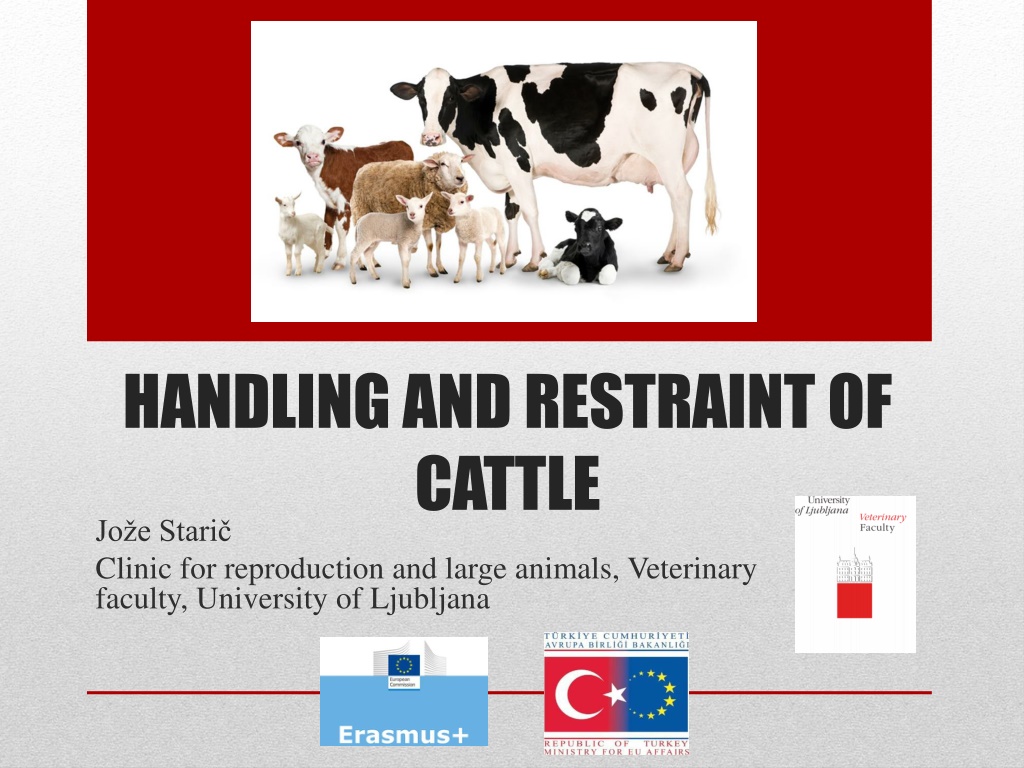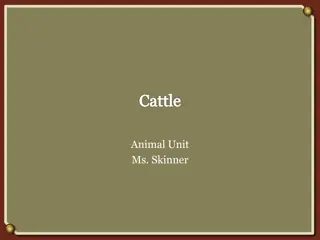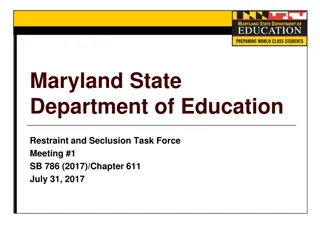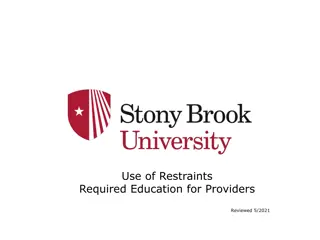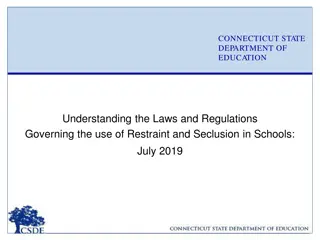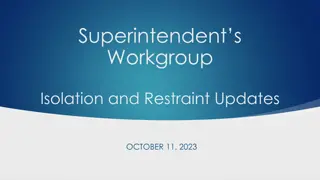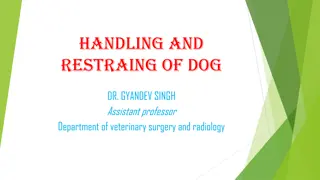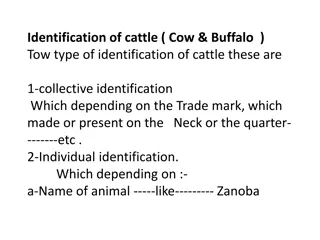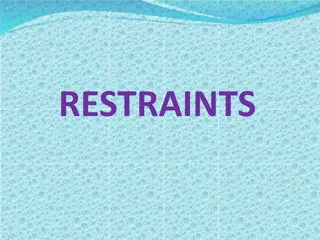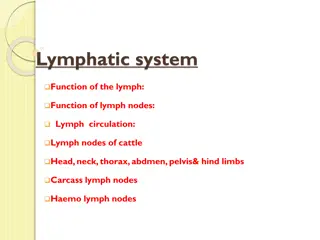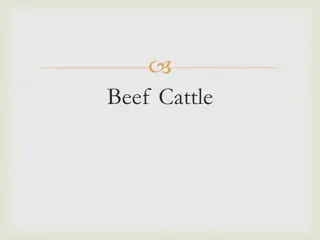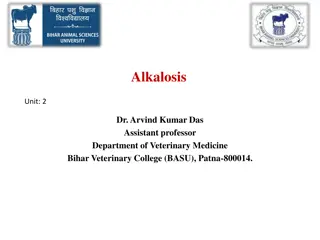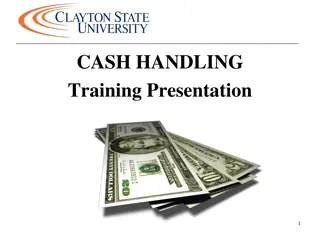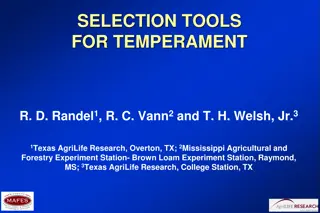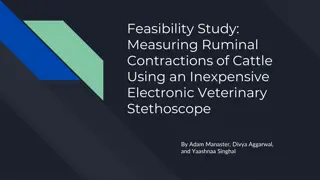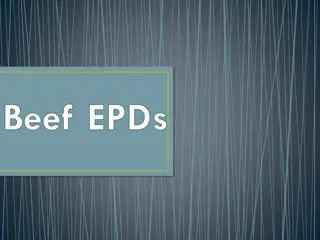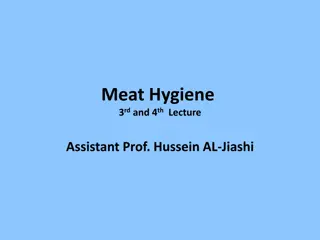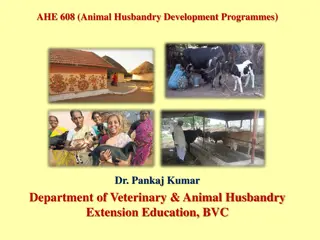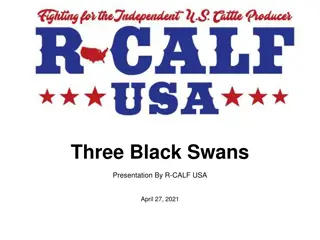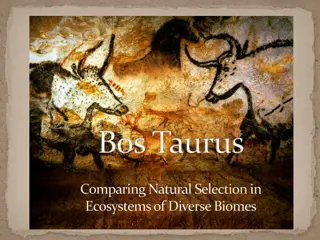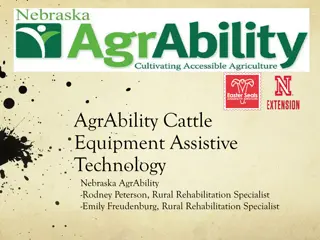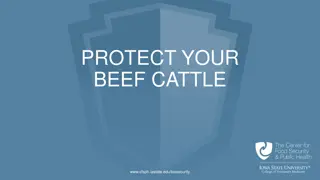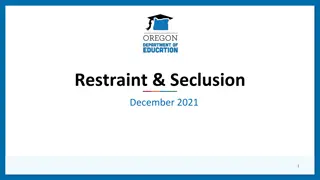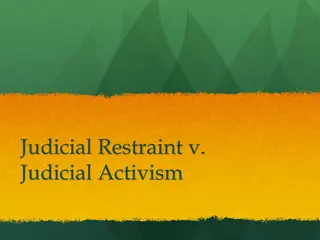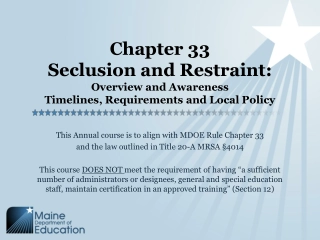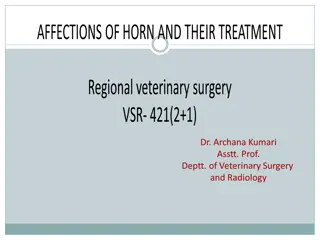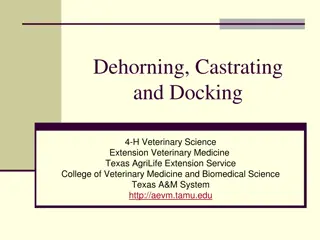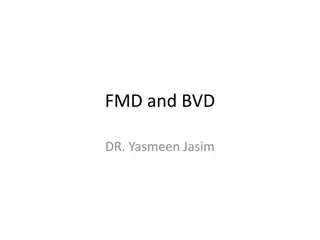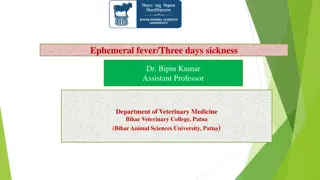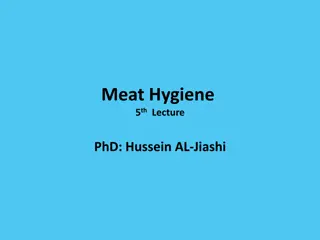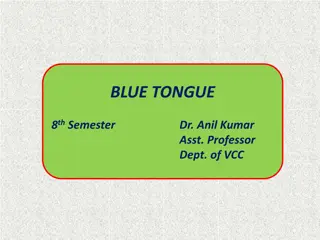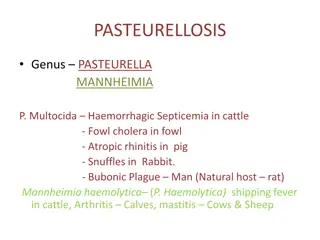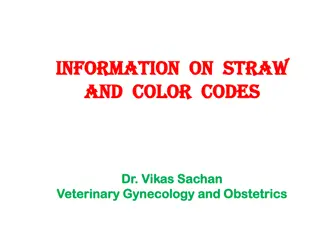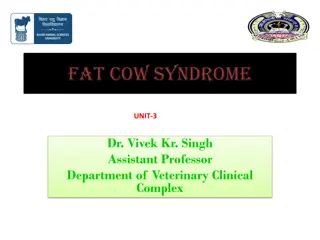Understanding Cattle Handling and Restraint Techniques
Explore the importance of understanding cattle senses and behaviors for effective handling and restraint. Learn about domestication history, handling techniques, sensory perception, and more to ensure safe interactions with cattle. Gain insights into vision, hearing, and other senses crucial for proper livestock management.
Download Presentation

Please find below an Image/Link to download the presentation.
The content on the website is provided AS IS for your information and personal use only. It may not be sold, licensed, or shared on other websites without obtaining consent from the author. Download presentation by click this link. If you encounter any issues during the download, it is possible that the publisher has removed the file from their server.
E N D
Presentation Transcript
HANDLING AND RESTRAINT OF CATTLE Jo e Stari Clinic for reproduction and large animals, Veterinary faculty, University of Ljubljana
Introduction Understanding senses & behavior of ruminants Handling cattle Approaching cattle Manual methods of fixation Fixation with basic equipment for restraint Moveing of recumbent cattle Cattle that are not used to handling OUTLINE
domesticated about ten thousand years ago religious reasons (important symbol for ancient people) production and as labor animals first separated from wild population and then selectively bred for many generations for productive traits as well as for tameness. Tameness is a heritable characteristic. The process of selection for tameness leads to relatively tame animals of nowadays, which allow interaction, handling and restraint by humans. Introduction
HANDLING TECHNIQUES take into consideration animal behavior and perception of surroundings
Act as prey They needed good senses to spot predators and avoid them. vision, hearing and smell are about equally important for ruminants provide information about what is going on in their environment All information obtained by senses goes through a sensory filter and reaches the brain, where it is processed on the basis of previous experiences, specific environment, specific weather conditions, even time of the day and so on, to determine if reaction is necessary and which action might be executed The senses and behaviors of domestic ruminants important for handling
Cattle have better hearing than small ruminants and humans. agitated when they hear dog barking, screaming or other sudden loud noises of high intensity. cannot define the source of sound well, so they need to combine hearing with vision. Hearing
Smell is very important to domestic ruminants. It is harder for us to understand and study smell, because our smell system is very rudimentary compared to ruminants. very important for predator detection & interaction between individuals Smell
1. 2. 3. 4. 5. 6. 7. Herding instinct Habitual instinct Follow the leader Alelometric instinct Maternal instinct Territorial instinct Hierarchy Understandingof ruminanatsbehaviour
important for the ability to handle them TEMPERAMENT Aggressive behavior of cattle is expressed by Quick, erratic movements, Raised, flicking tail, Pawing the ground, Turning sideways, Raised ears, Snorting. capable of inflicting serious injuries to humans need sedation or movement to stocks in order to approach them Behaviorcharacteristics ofruminants
The distance between the approaching person (or other animal) and ruminant when it is ready to flee is called the flight or escape zone. The distance of the flight zone depends on temperament of animals and previous experiences. Use of the flight zone allows humans to manage movement in ruminants. Flightzone
When handler crosses the point of balance, the animal will start moving in the opposite direction of the movement of the handler. Deep invasion into the flight zone or fast approach to it causes fear and agitation. Animals will start moving away faster and further. In cattle it is important to know, that if we approach an animal that is not used to handling too much it can become aggressive towards us.
Understanding animal senses and behavioral characteristics assists us in handling of them. Handling cattle always involves a risk of personal injury from crushing, kicking, butting or goring. Handling cattle in stressful conditions in disasters situations usually increases these risks! Injuries inflicted to humans are usually bruises, but bone fractures, contusions and lacerations are not rare. Adult cattle, especially bulls are life dangerous, but also cows with calves. Fatalities due to bulls attacks happen every year. Handlingofcattle
HOW CAN CATTLE INJURE US? Cattle can kick very strongly. Usually it kicks just with one hind leg towards the blind spot. It is important to know that it is capable to swing leg far forward, even in front of a shoulder before it kicks into the blind spot. Cattle rarely kick with both hind legs like horse. Never put your arm between a metal bar and a cow s leg.
Cattle gore with head, especially if they have horns. Cattle can run into humans and knock them down. Cattle can squeeze a handler between two animals or against firm objects, like poles or walls. Waving of tail can also seriously injure a cattle handler, especially if it hits the eyes. Cattle can also step o toes and crush them if we don t wear suitable foot wear.
Some categories of cattle cannot be approached. These are cattle that are not used to human contact, bulls if we are not familiar with them. Dairy cows most usually allow handling. Cattle that allow approach should be approached from the side and back. We should always alert cattle that we are approaching with calming call. Then we try to physically contact the animal with and on the back and lean with our body to it. All our movements should be smooth and secure. Comforting an animal by taking also helps. If they react aggressively, we need to consider sedating them before approaching or driving it into corridor and chute Approaching cattle
Fixation of head we grab the head with hand that is close to the animal under the opposite ear or horn and with the hand that is far from the animal we grab it under the chin and try to pull the head to the side Manualmethodsoffixation
Fixation of hind leg to prevent kicking pulling up of a skin fold just in front of the knee. The other option is also to pull the tail under the tie and towards the back.
Fixation of the tail and body (less likely to kick as well) when cattle cannot move forward and to sides due to physical obstacles we grab the tail about 30 cm from its base and press it up and forward, taking care not to injure it
Fixation of the body we lean with our back towards the animal s body and grab tail from the other side so it s bent towards us. This way the animal cannot move from us as the tail is going to cause pain and we are preventing movement in our direction by leaning on the animal.
Nose tongs - we put them in nostrils, which give us good control over head. Some animals do not permit placement of nose thongs. Fixation with basic equipment for restraint
Bonding of hind legs with rope this prevents kicking. We need a rope with fixed loop at the end to thread it in a fashion of figure 8 just above the hock joints of hind legs. Similar can be achieved also with custom made devices, like nylon leg tie for cows
For cattle that allow to be haltered and led, we can use halters. They need to be set behind the ears. When halter leading a cow, we have to stand by its shoulder or slightly more forward.
With fixation of head, legs, body and tail we prevent injuries that these animals can inflict us.
Moving a down cattle to soft bedding in a location protected from adverse weather will greatly enhance a healthy outcome. It is important that such animals are properly managed, with good food and fresh water that they can reach while recumbent. It is also very important to turn recumbent animals from one side to the other few times a day in order to prevent pressure injury of tissues that an animal is laying on. Moveing of recumbent cattle
We can try putting an animal in standing position. Before that we, have to be sure that it is capable of standing without any fractures, neurological dysfunction, etc. We can try force it to stand. If that does not give results we can use long rope that we thread around an animal so it is set below pin bones at the back and below sternum in the front. We need at least 5 people who try to pull up the animal, hind quarters first followed by front quarters.
Cow Lifter If our efforts are not effective, the animal can be moved to a specially prepared location where it can stay till it recuperates. If there is no special device for recumbent cattle movement available, the best way is to put it on a strong fabric, like plywood sheet and then pull the sheet with the animal on to the location.
If they are not used to handling we cannot handle them. Chemical restraint is necessary in such cases, which allows us to approach a cattle that is not used to human contact. Beside the danger of injuries, cattle can transmit some zoonotic diseases. CATTLE THAT ARE NOT USED TO HANDLING
